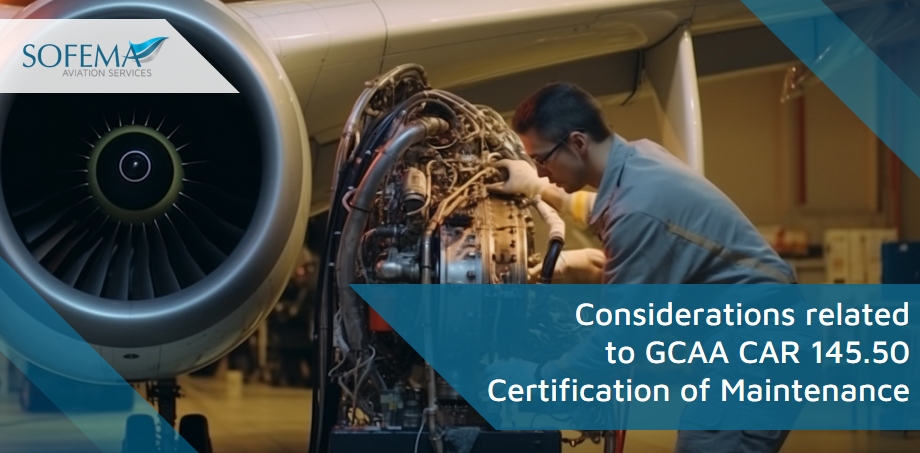Sofema Aviation Services (SAS) www.sassofia.com considers the legal obligations of the Gulf Civil Aviation Authority (GCAA) in respect of Aircraft Certification of Maintenance.
Introduction
A certificate of release to service shall be issued by appropriately authorised certifying staff on behalf of the organisation when it has been verified that all maintenance ordered has been properly carried out by the organisation following the procedures specified in 145.70, taking into account the availability and use of the maintenance data specified in 145.45 and that there are no non-compliances which are known to endanger the flight safety.
A certificate of release to service shall be issued before the flight after any maintenance.
New defects or incomplete maintenance work orders identified during the above maintenance shall be brought to the attention of the aircraft operator for the specific purpose of obtaining an agreement to rectify such defects or completing the missing elements of the maintenance work order.
- Note: when the organisation is unable to complete all maintenance orders, it may issue a certificate of release to service within the approved aircraft limitations. The organisation shall enter such fact in the aircraft certificate of release to service before the issue of such certificate.
A certificate of release to service shall be issued at the completion of any maintenance on a component whilst off the aircraft.
- The authorised release certificate ― AW Form 1 referred to in Appendix II to CAR-M constitutes the component certificate of release to service.
- When an organisation maintains a component for its own use, an AW Form 1 may not be necessary depending upon the organisation’s internal release procedures defined in the exposition.
AOG Special Arrangement
When an aircraft is grounded at a location other than the mainline station or main maintenance base due to the non-availability of a component with the appropriate release certificate, it is permissible to temporarily fit a component without the appropriate release certificate for a maximum of 30 flight hours or until the aircraft first returns to the mainline station or main maintenance base, whichever is the sooner.
- Subject to the aircraft operator agreement and said component having a suitable release certificate but otherwise in compliance with all applicable maintenance and operational requirements.
- Such components shall be removed by the above prescribed time limit unless an appropriate release certificate has been obtained in the meantime under paragraphs (a) and 145.42.
AMC 145.50(b) Certification of maintenance
The certificate of release to service should contain the following statement:
‘Certifies that the work specified except as otherwise specified was carried out in accordance with CAR-145 and in respect to that work the aircraft/aircraft component is considered ready for release to service’.
Reference should also be made to the GCAA Approved Maintenance Organisation Certificate number.
CRS in Aircraft Tech Log
It is acceptable to use an alternate abbreviated certificate of release to service consisting of the following statement ‘CAR-145 release to service’ (The introductory section of the technical log should include an example of the full certification statement).
The certificate of release to service should relate to the task specified in the (S) TC holder‘s or operator‘s instructions or the aircraft maintenance program which itself may cross-refer to maintenance data.
The date such maintenance was carried out should include when the maintenance took place relative to any life or overhaul limitation in terms of date/flying hours cycles/landings etc., as appropriate.
When extensive maintenance has been carried out, it is acceptable for the certificate of release to service to summarize the maintenance as long as there is a unique cross-reference to the work package containing full details of the maintenance carried out. Dimensional information should be retained in the work-pack record.
AMC1 145.50(d) Certification of maintenance
The purpose of the certificate (AW Form 1) is to release assemblies/items/components/parts (hereafter referred to as item(s) after maintenance and to release maintenance work carried out on such items under the approval of the GCAA and to allow items removed from one aircraft/aircraft component to be fitted to another aircraft/aircraft component.
- The certificate is to be used for export/import purposes, as well as for domestic purposes and serves as an official certificate for items from the manufacturer/maintenance organisation to users.
- It can only be issued by organisations approved by the GCAA and within the scope of the approval.
- The certificate may be used as a rotatable tag by utilizing the available space on the reverse side of the certificate for any additional information and dispatching the item with two copies of the certificate so that one copy may be eventually returned with the item to the maintenance organisation.
- The alternative solution is to use existing rotatable tags and also supply a copy of the certificate.
A certificate should not be issued for any item when it is known that the item is unserviceable except in the case of an item undergoing a series of maintenance processes at several maintenance organisations approved under CAR-145 and the item needs a certificate for the previous maintenance process carried out for the next maintenance organisation approved under CAR-145 to accept the item for subsequent maintenance processes. In such a case, a clear statement of limitation should be endorsed in Block 12.
Next Steps
Follow this link to our Library to find and download related documents for Free.
Sofema Aviation Services www.sassofia.com and Sofema Online www.sofemaonline.com provide classroom, webinar and online training for EASA, FAA as well as UAE GCAA regulations. Please see the associated website or email team@sassofia.com.
Tags:
Aircraft Maintenance, Aviation Maintenance, aviation safety, SAS, SAS blogs, Aircraft Certification, Gulf Civil Aviation Authority (GCAA), CCAR-145, GCCA, AMC1 145.50(d)





